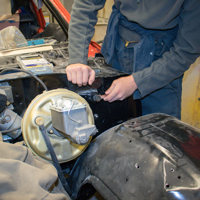Exploring
Careers
There's a career path for everyone, let's find yours.
Future In
Demand Jobs
Thinking about a career? Learn what jobs are going to be in demand when you graduate.
Work-Based
Learning
Interested in learning on-the-job? Check out internships, apprenticeships, and more.
Start Your
Own Business
Explore entrepreneurship as a career opportunity. Start exploring.
Explore Careers
Webster's Dictionary defines career as "an occupation undertaken for a significant period of a person’s life and with opportunities for progress."
An occupation for a significant period of one's life? You read that right. That’s why it's important to start exploring your interests and options as early as possible. By no means must you have your career path figured out by the time you graduate, but it's important to know what interests you and what doesn't interest you.
Exploring and Choosing Your Career
Choosing A Career
How Does One Start on This Path?

- Reflect – Think about your likes, dislikes, and passions. Reflect on the classes you take in school and which ones you liked the most (or not at all). Think about your talents and skills. Do you like working with your hands, being outside, or writing essays on a laptop?
- Explore - Sometimes it’s helpful to think broadly about the type of career you want, instead of focusing on a specific occupation. Montana Career Pathways can help you explore opportunities in sixteen different pathways.
- Action - Use what you’ve learned about yourself and channel it into one of the paths outlined below. Job shadow, find an internship, or sign up for a work-based learning program through your school. By taking action, you'll find out quickly if a potential career is the right fit or not.
What Kinds of Jobs will be Needed in the Future?
Wouldn't it be great to have a crystal ball that could predict what workers will be doing in the future? Some predict that up to 85% of the jobs that will exist in 2030 haven't been invented yet; however, the smart folks at the Montana Department of Labor and Industry have analyzed the data to provide some insight into the work we'll be doing in the future. Check it out!
Start Exploring with MCIS
Montana Career Information System is a tool available for teens and families to link interests and skills to occupations. This is a service provided through the Montana Department of Labor and Industry to help students create a customized, personal learning plan. You can create a profile and take the skills and interests assessments that will identify potential occupation matches based on your interests and skills.
Montana Career Information System (MCIS)
Need a Reality Check?
Work-Based Learning in High School

In simple terms, work-based learning is learning about work, at work. Work-based learning happens through several different structures and can be customized to fit the needs of students, businesses, and communities. Here are a few examples:
- Work-Site Tours and Job Shadows: Brief, observational, onsite visits to workplaces.
- Work Experiences: Students often get their first job while in high school. No matter the job, there are skills and experiences to learn from any job.
- Internships: Short-term, on-the-job experiences, usually three to six months. Can be paid or unpaid, and focuses on in-depth career exploration. Can be offered virtually, in-person, or hybrid (in-person and virtually).
- Apprenticeships: One-to-five year commitment, pairing classroom instruction with paid, supervised, on-the-job training that leads to an industry-recognized degree or credential. Reach Higher Montana facilitates apprenticeship opportunities for students. Check out our apprenticeship program.
Depending on your school’s policies, you may be able to earn academic credit for your work-based learning experience. Visit with your teacher or school counselor to learn more.
Work-Based Learning
Internships and Apprenticeships
Entrepreneurship - Start Your Own Business
Have a great idea for a product or service that is needed in your community? You can start your own business to meet these needs. Here are some ways you can explore entrepreneurship as a career opportunity:
- Find out what it takes to be a successful entrepreneur - Get involved with clubs like DECA or BPA to develop your business acumen. Interview or job shadow an entrepreneur to learn about their path to starting a business.
- Get EMPOWERED - This program is offered in many Montana high schools and can help you launch your business idea.
